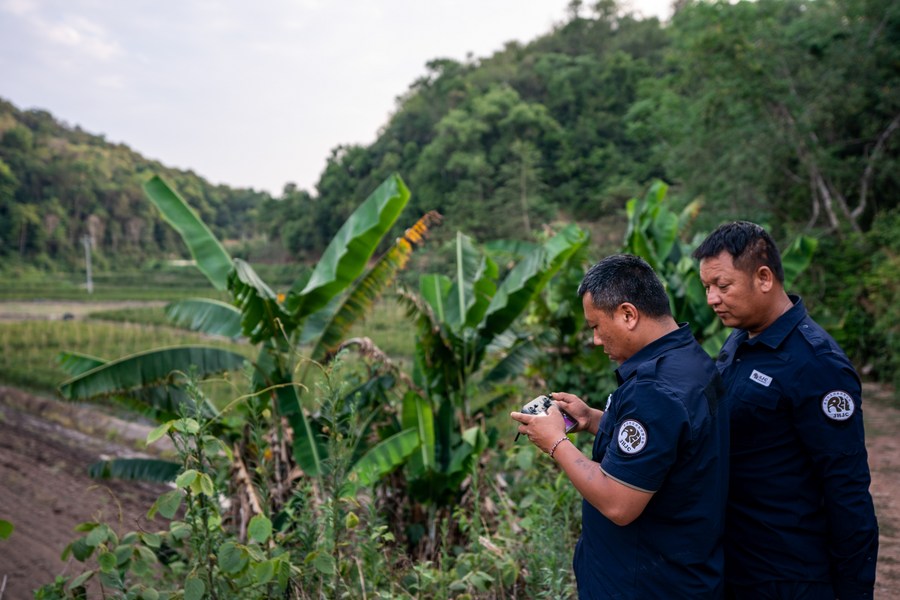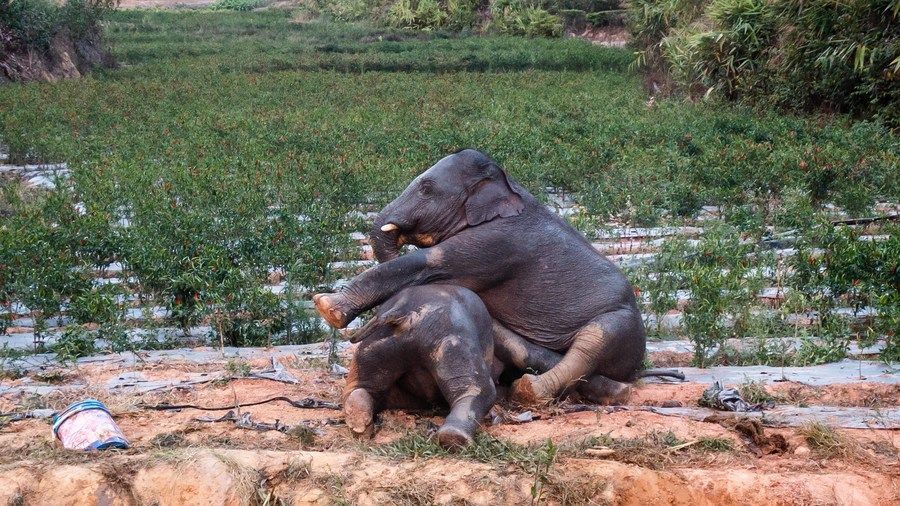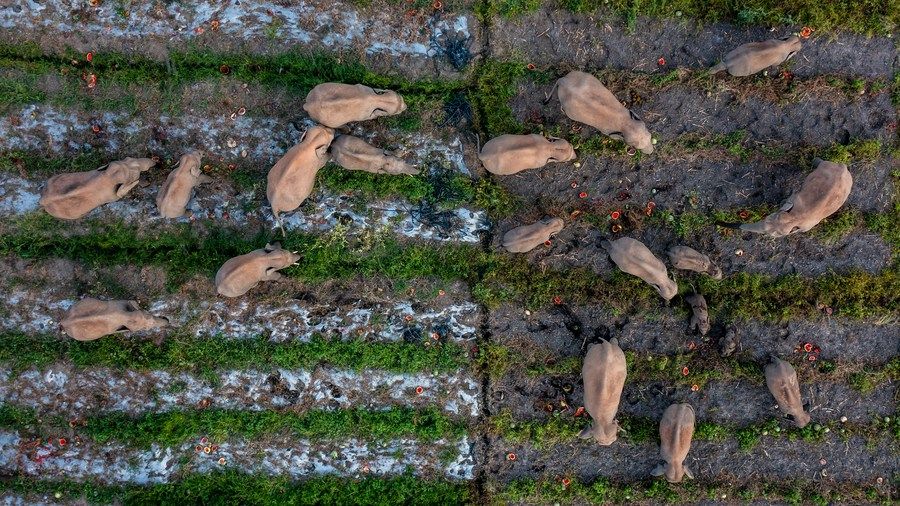



* By the end of 2021, the elephant population in Yunnan, the main habitat of the animal in China, had reached approximately 360 individuals, showcasing a significant increase from less than 150 elephants recorded in 1976.
* In efforts to enhance the protection of Asian elephant habitats and improve their quality, China has established 11 nature reserves spanning an area of 5,098 square kilometers in regions where the Asian elephants are distributed.
* Yunnan has also launched the Asian elephant breeding and rescue center in Xishuangbanna, which has successfully rescued 30 stranded or injured wild elephants over the past 20 years.
KUNMING, May 25 (Xinhua) -- After years of incredible adventures, the elephant herd that gained widespread recognition for its epic journey through southwest China's Yunnan Province has now found solace in the familiarity of their hometown, as they are embracing the growth of their community and ushering in a new chapter in their lives.
According to experts, wild elephants are highly social animals, and the increase in the number of elephants and elephant families signifies a positive trend in the healthy reproduction of these majestic mammals.
LIFE BACK IN HOMETOWN
As the evening of May 9 approached, Peng Jinfu eagerly lifted his telescope, peering into the distance towards the mountainous forests of Dahuangba Village, Dadugang Township, in Yunnan's Xishuangbanna Dai Autonomous Prefecture. With anticipation in his voice, he whispered to himself: "It's time for the elephants to come down."
As expected, more than 20 majestic creatures slowly emerged from the trees, wagging their ears and their tails as they entered a watermelon field for a satisfying meal.

Wild elephant monitors Peng Jinfu (L) and Pu Yongbing fly an unmanned aerial vehicle to monitor elephants in Dadugang Township, Xishuangbanna Dai Autonomous Prefecture in southwest China's Yunnan Province, May 11, 2023. (Xinhua/Hu Chao)
"The elephants usually come out for food at about 5 p.m., and return to the woods around 8 or 9 a.m. the next day," said Peng as he flew an unmanned aerial vehicle close to the elephants, filming and photographing them. His apprentice, Pu Yongbing, sent out early warning messages in WeChat groups to nearby villagers, urging them to maintain a safe distance from the majestic creatures.
These dedicated individuals monitor wild elephants by utilizing various techniques such as aerial surveillance and thermal imaging. They track the herds and provide early warning to nearby villagers as well as offer monitoring data for scientific research.
Through extensive observation, Peng became familiar with individual elephants, recognizing them by their size, ears and the shape of their nose.
According to his observations, there are currently two elephant groups roaming around together in the township. The majority of the wild elephants belong to the "Ranran family," while the other group, known as the "short-nose family," consists of four adult females, one sub-adult male, and two young elephants.

This aerial photo taken on May 9, 2023 shows two young elephants playing in Dadugang Township, Xishuangbanna Dai Autonomous Prefecture in southwest China's Yunnan Province. (Xinhua/Hu Chao)
"The two young ones had noticeably grown plumper since returning from their remarkable journey," Peng said.
In March 2020, the "short-nose family" left a forest nature reserve in Xishuangbanna and trekked about 500 km northwards to the provincial capital Kunming, finally arriving in June 2021. They have since headed south again, making a safe return to the nature reserve.
NEW MEMBERS, NEW FAMILIES
"The size of an elephant family typically ranges from eight to 15 individuals, with the eldest female assuming the role of family leader, guiding the herd in their movements, feeding, and resting patterns," said Chen Fei, director of the Asian elephant research center at the National Forestry and Grassland Administration.
As the population grows to a certain size, closely related sisters or mother-daughter pairs would form new families alongside their offspring, searching for new habitats and causing the elephant family to disperse into separate groups.
In June 2022, the "short-nose family" split into two groups and explored different areas. It welcomed a newborn calf last December. Now, the family consists of 20 members in total, with 13 active around Xishuangbanna's Puwen Township, and seven around the prefecture's Dadugang Township together with 23 wild elephants of the "Ranran family."

This aerial photo taken on May 9, 2023 shows elephants belonging to the "Ranran family" and the "short-nose family" foraging in Dadugang Township, Xishuangbanna Dai Autonomous Prefecture in southwest China's Yunnan Province. (Xinhua/Hu Chao)
"The splitting and merging of elephant families is a natural phenomenon, driven by the elephants' need for optimal survival and reproduction," Chen said, adding that given their massive size, Asian elephants require a significant amount of food and water on a daily basis, necessitating constant migration in search of these resources. "Consequently, families may join forces with others during this process."
Field monitors reported that in recent years, almost every wild Asian elephant herd in Yunnan's Xishuangbanna and Pu'er has experienced an annual influx of newborns. By the end of 2021, the elephant population in Yunnan, the main habitat of the animal in China, had reached approximately 360 individuals, showcasing a significant increase from less than 150 elephants recorded in 1976.
"Such heartening development signals significant achievement in China's biodiversity conservation efforts. At a time when the global population of Asian elephants is dwindling, the 'baby boom' of wild elephants in China represents a milestone in preserving ecological balance," said Wan Yong, head of the provincial forestry and grassland bureau.
HARMONIOUS COEXISTENCE
Asian elephants, the continent's largest land animal, are under top-level protection in China. They are mainly scattered in Yunnan's Xishuangbanna, Pu'er and Lincang.
"There is no safer country for Asian elephants than China," said Jose Ahimsa Arceiz, a Spanish ecologist based at the Xishuangbanna Tropical Botanical Garden of the Chinese Academy of Sciences, adding that China's experience in resolving the "human-elephant conflict," if successful, could lead the world.
In efforts to enhance the protection of Asian elephant habitats and improve their quality, China has established 11 nature reserves spanning an area of 5,098 square kilometers in regions where the Asian elephants are distributed.
Yunnan has also launched the Asian elephant breeding and rescue center in Xishuangbanna, which has successfully rescued 30 stranded or injured wild elephants over the past 20 years, accumulating extensive expertise in the rescue of wild Asian elephants and nurturing abandoned calves.
In 2010, Yunnan became the first provincial-level region in China to introduce commercial insurance for the damage caused by wildlife, with the entire province coming under insurance coverage by 2014.

This aerial photo taken on May 9, 2023 shows the view of an "elephant canteen" in Dadugang Township, Xishuangbanna Dai Autonomous Prefecture in southwest China's Yunnan Province. (Xinhua/Hu Chao)
To mitigate human-elephant encounters and enhance the elephants' food resources, numerous food stores, dubbed "elephant canteens," have been strategically set up throughout various locations in Yunnan, providing the animals with attractive and nutritious meals.
"We must strive to ensure humans and elephants are living in harmony with each other." said Chen. ■
(Video reporters: Sun Min; video editors: Zhang Qiru, Hong Yan)
Copyright © 2001-2025 湖北荆楚网络科技股份有限公司 All Rights Reserved
互联网新闻信息许可证 4212025003 -
增值电信业务经营许可证 鄂B2-20231273 -
广播电视节目制作经营许可证(鄂)字第00011号
信息网络传播视听节目许可证 1706144 -
互联网出版许可证 (鄂)字3号 -
营业执照
鄂ICP备 13000573号-1  鄂公网安备 42010602000206号
鄂公网安备 42010602000206号
版权为 荆楚网 www.cnhubei.com 所有 未经同意不得复制或镜像